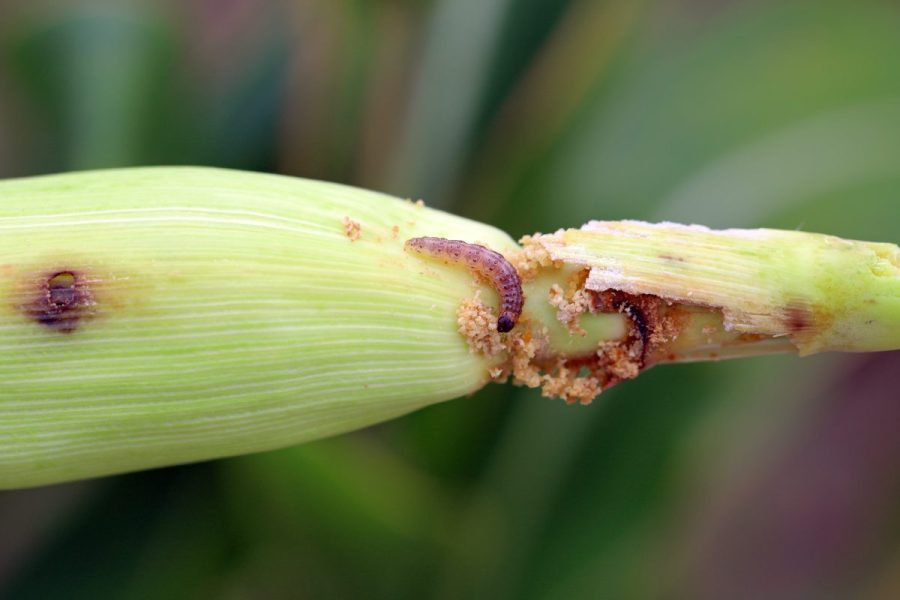A migratory pest appears to have capitalised on this summer’s prolonged arid conditions, attacking maize crops and leaving tunnels of destruction. CPM investigates the rise of the European corn borer.
“During the past five years there’s been an increase in European corn borer reports, including sightings in our own maize trials.” TIM RICHMOND
By Janine Adamson
Given increased sightings in UK maize crops this summer, the European corn borer – Ostrinia nubilalis – seems to be having a rather good year.
While it might not be the first pest that springs to mind when it comes to maize, its growing presence could be an early warning sign for what’s on the horizon, suggests Limagrain’s Tim Richmond.
He first heard of the pest around 10 years ago and admits given it was a specific, isolated case, he dismissed it at the time. “But during the past five years there’s been an increase in ECB reports, including sightings in our own maize trials in 2022.
“This year, it appears to have spread further, even reaching the West Midlands and Lincolnshire. As with all moths, including beet moth, this is likely to be related to the weather – prolonged warm, dry temperatures enabling more generations and providing better flight conditions,” explains Tim.
When assessing Limagrain varietal trials this year, where affected, around one in 20 plants have been infected with ECB, he adds. “So it’s not at a level that we’d class as an economic problem yet, but if populations continue to increase as they have been doing it could be far more significant in 5-10 years,” he suggests.
POLYPHAGOUS PEST
Looking in more detail, ECB is widespread across Europe, North Africa and North America. It’s polyphagous, primarily of grasses, but also attacks a range of crops such as apples, strawberries, peppers, maize and sweetcorn.
ECB was first spotted in the UK feeding on mugwort in the 1930s, but it wasn’t until 2010 that a grower in south west England contacted authorities regarding caterpillars boring into maize stems. The species was later confirmed as ECB.
As a mostly migratory insect, the adults appear in Europe in June, laying eggs on the underside of leaves. Once hatched, larvae feed on the leaves, and in the case of maize, bore into the upper part of the plant. Following this, second generation larvae tunnel into stem internodes before pupating in situ, or in the soil.
An infestation in maize in particular can reduce yield with fewer kernels per ear, increase harvest time due to lodging, and affect quality due to disease and mycotoxin contamination. Studies indicate that just one ECB per maize plant can reduce yield by 3-5%.
“If maize is being grown for grain it’s a particular problem,” states Tim. “Not only is there a yield loss, but there’s also the visual impact too. In a forage scenario, it’s more apparent as crops mature as this is when ECB bores into the stem, preventing the translocation of water and nutrients and creating weakness,” he explains.
Maize Growers Association’s Jon Myhill adds that he’s seen ECB larvae exit just below the cob or even through it, causing unpredictable lodging that can resemble wildlife damage. “Insect excrement on the stem is often the first visible sign. With two generations per year and larvae pupating inside the stem, control is challenging.”
Research suggests that ECB is active from 10oC onwards, which coincides with the recommended temperature for UK maize planting. Tim points out that this means in theory, the threat to maize is all season long.
While the pest is primarily migratory, risk level increases because it can also overwinter for up to three months, even in temperatures as low as -20oC, explains Koppert UK’s Dr Richard Binks. “There appears to be a geographical hot-spot developing across the Isle of Wight and southern England.
“ECB might not be perceived as a huge issue in the UK at the moment, but with a reducing armoury of insecticides, we believe there’s a growing demand for alternative control solutions,” he says.
To complicate matters further, there are two races of ECB – the ‘E’ race which feeds on Artemisia species (mugwort, sagebrush), and the ‘Z’ race that preferentially feeds on Zea mays (maize, corn). Both are identical in appearance, but the female moths produce different ratios of pheromones.
According to the Defra website, there’s no information currently available on the distribution of the different races within the UK.
So where do growers start in mitigating the risk of ECB? Because of its capacity to overwinter, one method could be to destroy maize stubble/residues and therefore remove ECB’s host. However, Tim points out that because the pest tends to congregate in densely populated areas such as hedgerows and field margins, this won’t necessarily eradicate the issue completely.
Then, sites which are most at risk are those which grow continuous maize. According to Jon, cultural practices such as 25cm ploughing and a one-in-three-year maize rotation are key to breaking the cycle, he advises.
There’s also FMC’s Coragen (chlorantraniliprole) – an insecticide which has a label recommendation for ECB in forage and grain maize, and sweetcorn.
However, biological products could prove a more sustainable solution long-term, comments Richard. “There are two potential concepts which are well established on the Continent; the UK is essentially playing catch up.
“The first is using a parasitic wasp of the Trichogramma species – which parasitises the moth’s eggs. Application tends to be via drone which can release capsules containing Trichogramma eggs into the crop,” he explains.
The second solution could be to apply entomopathogenic nematodes, continues Richard. “This is already being explored in UK vegetable crops to help combat wireworm pressure. We’re looking to trial this in maize and sweetcorn as soon as next year, also utilising drone application but spraying a nematode-loaded solution.
“Both of these biological approaches are at the proof of concept stage of development in the UK. To realise their potential, we require growers to consider their value versus a more traditional solution, for example, using an insecticide.”
MONITORING
As for knowing when ECB pressure is a problem, the starting point is to monitor. How this is achieved depends on the race of ECB (E or Z), points out Richard. “This has an impact on which pheromones are used to attract the pest.
“In terms of the trap itself, you can use a Deltatrap with a species-specific pheromone. You could also use a large Core trap, which is essentially a wire mesh cage hung from a tripod stand.”
When considering the early symptoms to look out for, this involves inspecting maize crops for horizontal rows of holes in young leaves, caused by larval feeding. Later indications include waste and holes which should be visible on stems, or on the apical part of maize ears.
Physically speaking, adult ECB moths are around 22-32mm in size, while the eggs are flattish around 1mm in diameter, and are laid in a mass which overlaps similar to roof tiles. Larvae are up to 25mm long with a pale body and dark spots; the head is brownish black (see main picture).
From a breeder’s perspective, Tim says as the pest isn’t currently economically damaging, it’s unlikely pipeline maize varieties will be selected with traits to specifically overcome ECB feeding damage. “Although we do have to better recognise the symptoms when screening varietal trials.
“In the past, brackling may have been recorded in plots but it could have actually been ECB. I know this is something that our trial partners will be paying closer attention to in the future.”
Perhaps interestingly, Tim highlights that when accessing Defra’s UK Risk Register for Ostrinia nubilalis,the pest is considered low risk and as of July 2020, information associated with it was no longer being actively maintained.
It states that this will only be updated if new information is received that indicates the potential for a significant increase in risk to the UK. “Limagrain will be contacting Defra regarding our increased sightings and recommend that if anyone else has experienced a problem with the pest this season, that they do so too, or speak to their local APHA plant health and seeds inspector,” concludes Tim.
This article was taken from the latest issue of CPM. Read the article in full here.
For more articles like this, subscribe here.
Sign up for Crop Production Magazine’s FREE e-newsletter here.




